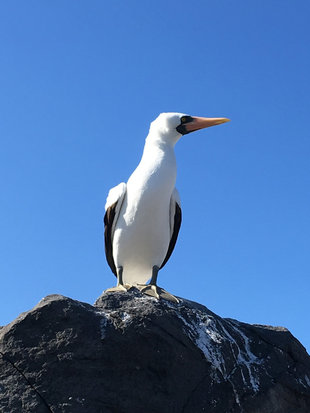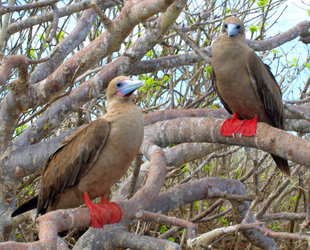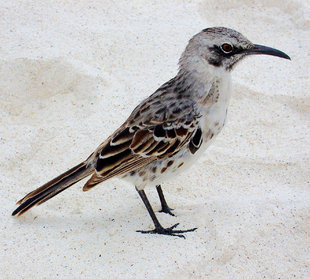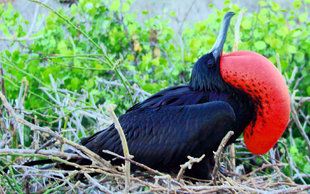Area Size: 145 Km²
Maximum Altitude: 76 metres
Island Highlights: Darwin Bay, Prince Phillips's Steps, Frigatebird, Hammerhead Shark, Marine Iguana
Introduction
Genovesa is a horse shoe shaped island, situated in the north east of the Galapagos Islands, somewhat removed from the rest of the archipelago. She is the only frequently visited island that lies entirely above the equator, invoking numerous ceremonies for passengers who have never crossed it by sea before.
She is a fascinating island, whose array of birdlife often makes her referred to as "Bird Island", a name in which she most certainly lives up to. Her general abundance of wildlife and striking landscapes provides some excellent photographic opportunities.
A significant area of interest on Genovesa is Prince Phillip's Steps: a trail carved directly into the rocky volcanic island walls, which leads up a 25 m high cliff. The name Prince Phillip's Steps derived from a visit by the British monarch in 1964. It presents a spectacular vantage point from which to survey the rest of the island and is the ideal viewing point for spotting birds.
Wildlife
Prince Phillip's steps leads to a narrow stretch of land that opens out onto the plateau overlooking Darwin Bay. The trail leads through areas abundant in dry vegetation and dominated by the incense tree or palo santo (holy stick). This is also a popular nesting area for frigatebirds and red-footed boobies, who wrap their webbed feet around branches to perch in the bushes. In contrast, their "Nazca booby" cousins congregate around the surface of the scrublands beyond. The trail eventually leads to a spectacular colony of seabirds, which truly is an "ornithologist's dream".
The sheltered pools that lie in the rocky outcrops of the volcano are the starting point to another trail, which leads up to a cliff overlooking the caldera (mouth). Swallow-tailed gulls, which are the only nocturnal gulls in the world, can be seen nesting in their pairs at the cliff's edge. Lava gulls and pintail ducks are often spotted riding the sea breezes nearby. Other likely bird encounters include the Galapagos dove, mockingbird and short-eared owl.
Marine Life
The abundance of marine life in Darwin Bay makes for some excellent snorkelling. Potential encounters include marine iguanas, eagle rays, hammerhead sharks, fur seals and sea lions.
A rather unique dive site on Genovesa includes diving from the outside of the volcano through the channel into the caldera. The rocky bottom attracts a wealth of marine life, including schools of marbled groupers, jacks and barracuda. Manta rays may also be seen.
Geology
Genovesa is a low-lying island whose lava originated primarily from a crater in the centre of the island to form a shield volcano. There have not been any known eruptions in recorded history on Genovesa, but young lava flows can be seen on flank of volcano. The submerged crater is circular in shape with the rim approximately 600 metres (2,000 ft) across and 60 metres (200 ft) deep. On the floor of the crater, a lake has formed with a diameter of around 350 metres (1,150 feet).
Darwin Bay is characterised by its beautiful coral white sandy beach, formed after the island's large crater collapsed below sea level. Access is by means of a wet landing i.e. stepping off the side of a small inflatable, or panga, into shallow water. Once ashore, visitors are greeted by an overwhelming amount of birdlife, including masked boobies soaring overhead and great frigatebirds, which show off their bright red gula pouches.
Genovesa




